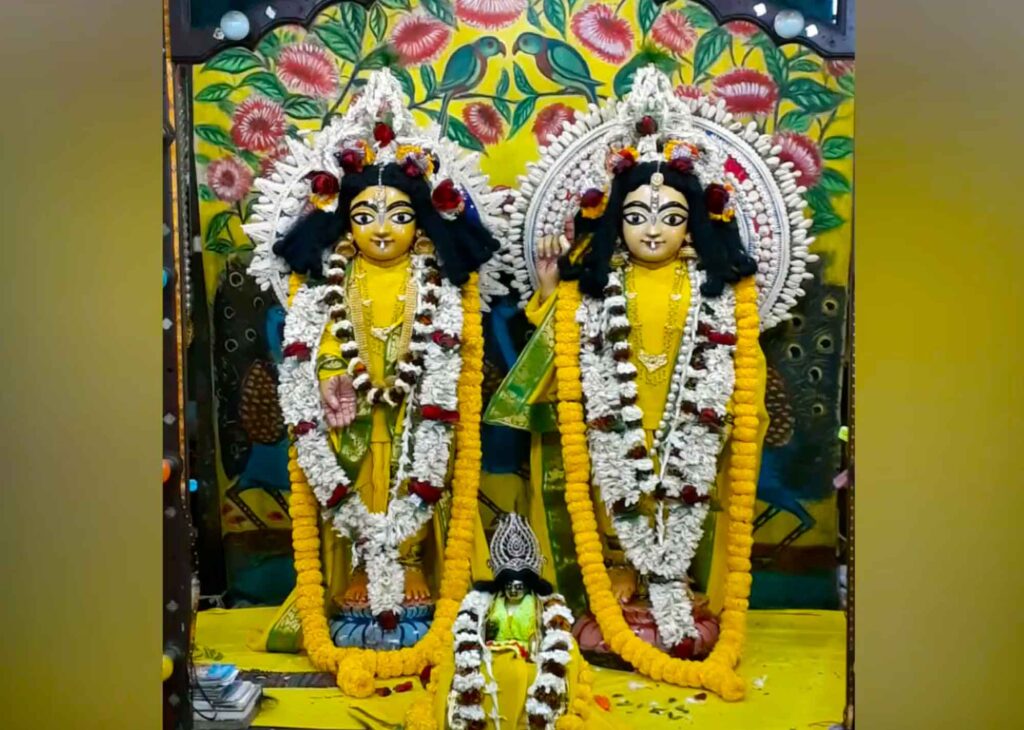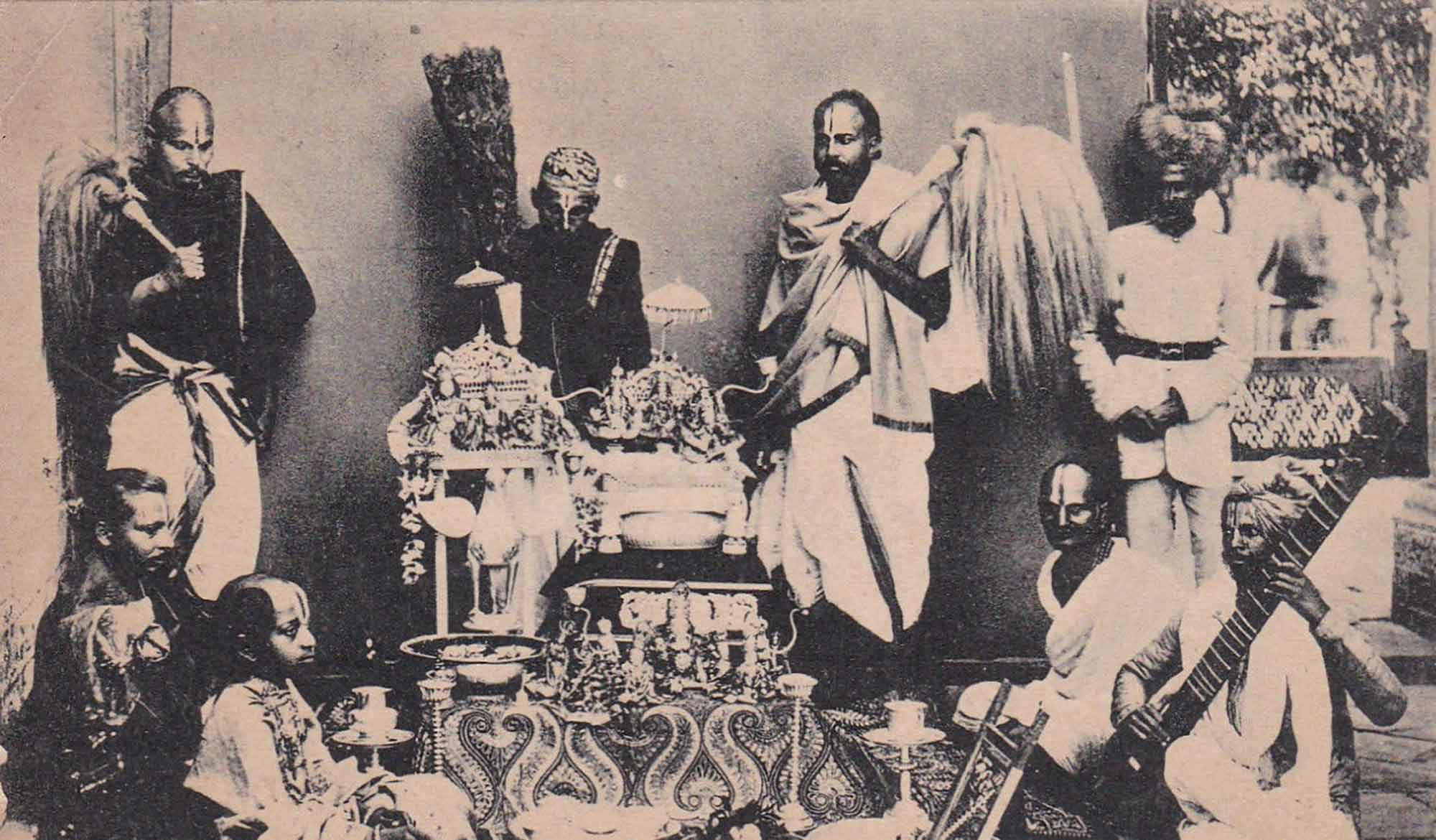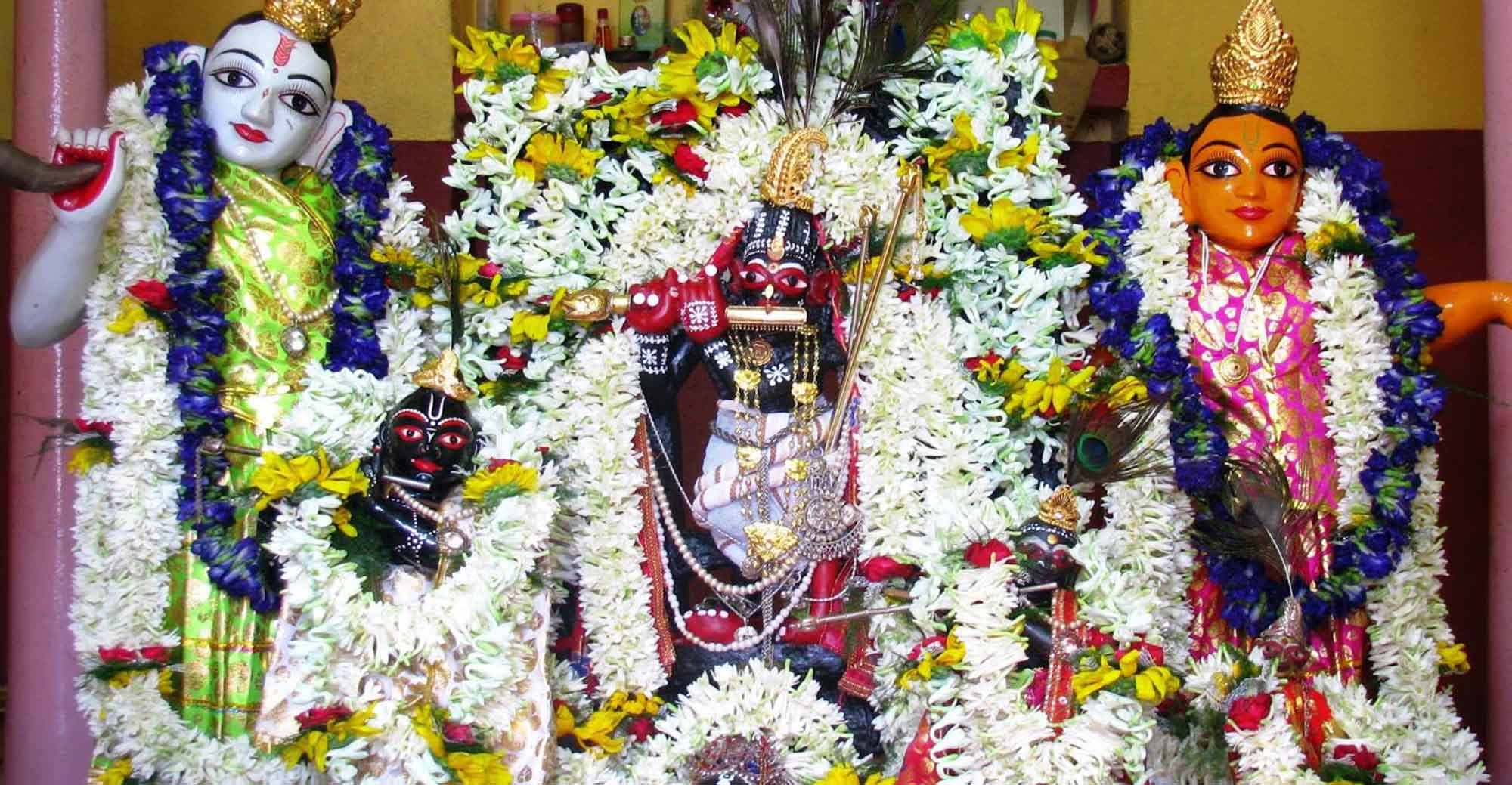Overview
‘Śrīmad Bhāgavatācārya’ was first published in Sajjana Toṣaṇī, Vol.9 Issue 12 in 1898. In this detailed biography of Śrī Bhāgavatācārya, Bhaktivinoda Ṭhākura describes the service of Bhāgavatācārya to Mahāprabhu and reveals a secret about the city of Kolkata.
(translated by Swami B.V. Giri)
There is a famous village called Varāhanagara in the north of the metropolis of Calcutta. Four hundred years ago, a fortunate brāhmaṇa-paṇḍita named Raghunātha lived in this village. Due to divine association, he had acquired śraddhā for the Śrīmad Bhāgavata from his childhood. After studying literature, grammar etc. he tried to attain kṛṣṇa-bhakti according to the advice sa vidyā tan-matir yayā (‘That by which one focusses upon the Lord is knowledge’). Due to good fortune, a jīva attains a taste for the Śrīmad Bhāgavata. There are many books on dharma in the world, yet the Śrīmad Bhāgavata is naturally the crown-jewel amongst them all. The second śloka of the First Canto states that this Bhāgavata, which is received by those sādhus who are free from envy, is completely devoid of deceit and propagates the highest dharma. The Bhāgavata is known to factually award supreme auspiciousness and is the destroyer of the threefold miseries. The Śrīmad Bhāgavata was composed by the great muni Śrī Nārāyaṇa. When the Śrīmad Bhāgavata is present, what is the use of any other śāstra? The Supreme Lord is immediately captured in the heart of those who desire to hear the Bhāgavata.
The most fortunate young brāhmaṇa who was a resident of Varahānagara, started studying the Śrīmad Bhāgavata from his childhood. There is no doubt that he studied the Bhāgavata with pure devotees. And why not? After hearing his explanation of the Bhāgavata, the Lord of our life Gauracandra, was absolutely satisfied and gave him the name Śrī Bhāgavatācārya.
It is easy to see what kind of scholar Mahāprabhu would call Bhāgavatācārya. At the time when Mahāprabhu was performing His līlā in Śrī Navadvīpa, there was a famous ācārya and mahā-mahopādhyāya of the Śrīmad Bhāgavata in Vidyānagara, by the name of Devānanda who was expert in all areas of knowledge. Everyone from Navadvīpa used to go to Vidyānagara to listen to his recitation of the Bhāgavata. Even before the birth of Śrīman Mahāprabhu, Devānanda Paṇḍita was famous as an ācārya for his interpretation of the Śrīmad Bhāgavata. Mahāprabhu himself, being a teacher and a propagator of bhakti, was very dissatisfied with the teachings and explanations of Devānanda which were averse to bhakti. After a long time, by the mercy of Vakreśvara Paṇḍita, Devānanda came to understand pure bhakti-tattva. After understanding the true meaning of Śrīmad Bhāgavata, our Mahāprabhu was satisfied with his explanation of the Bhāgavata.
That Mahāprabhu, who found fault with the interpretations of the Bhāgavata given by the paṇḍitas of Navadvīpa, and who taught the scholars of many other places the true meaning of the Bhāgavata – He was the one who listened to Raghunātha’s explanation and gave him the title of bhāgavatācārya. It is therefore concluded that according to the concept of vidyā-bhāgavatāvadhi (‘one’s learning is based upon one’s understanding of the Bhāgavatam’), there was no philosophical scholar like Bhāgavatācārya at that time.
The immense mercy of Mahāprabhu towards Śrī Bhāgavatācārya has been written about by Vṛndāvana Dāsa Ṭhākura in the fifth chapter of the Antya-khaṇḍa of Śrī Caitanya-bhāgavata (5.109-122):
hena-mate pānihāṭī-grāma dhanya kari
āchilena kata-dina śrī-gaurāṅga-hari
(“Thus, Śrī Gaurāṅga-Hari blessed the village of Pānihāṭi by staying there for a few days.”)
tabe prabhu āilena varāha-nagare
mahā-bhāgyavanta eka brāhmaṇera ghare
(“Then the Lord went to Varāhanagara and stayed in the home of one extremely fortunate brāhmaṇa.”)
sei vipra baḍa suśikṣita bhāgavate
prabhu dekhi bhāgavata lāgilā paḍite
(“That brāhmaṇa was expert in the Bhāgavata. When he saw the Lord, he began to recite it.”)
śuniyā tāhāna bhakti-yogera paṭhana
āviṣṭa hailā gauracandra nārāyaṇa
(“Hearing him speak about bhakti-yoga, Gauracandra Nārāyaṇa became ecstatic.”)
bala bala bale prabhu śrī-gaurāṅga-rāya
huṅkāra garjana prabhu karaye sadāya
(“Lord Śrī Gaurāṅga Rāya said, “Speak! Speak!” and the Lord roared repeatedly.”)
sei vipra paḍe parānande magna haiyā
prabhu o karena nṛtya bāhya pāsariyā
(“As that brāhmaṇa read, he was immersed in supreme bliss, and the Lord lost all external consciousness as He danced.”)
bhaktira mahimā-śloka śunite śunite
punaḥ punaḥ āchāḍa paḍena pṛthivīte
(“Hearing again and again those ślokas glorifying bhakti, the Lord continuously fell to the ground.”)
hena se karena prabhu premera prakāśa
āchāḍa dekhite sarva-loke pāya trāsa
(“In this way, displaying prema, the Lord would frighten everyone when they saw Him fall to the ground.”)
ei mata rātri tina-prahara-avadhi
bhāgavata śuniyā nācilā guṇa-nidhi
(“Thus, that Ocean of divine qualities, while hearing the Bhāgavata, danced for nine hours that night.”)
bāhya pāi vasilena śrī-śacīnandana
santoṣe dvijere karilena āliṅgana
(“When Śrī Śacīnandana regained His external consciousness, He happily embraced the brāhmaṇa.”)
prabhu bale bhāgavata e mata paḍite
kabhu nāhi śuni āra kāharo mukhete
(“The Lord said, ‘I have never before heard such an explanation of the Bhāgavata from anyone,”)
eteke tomāra nāma bhāgavatācārya
ihā vinā āra kona nā kariha kārya
(“’Therefore your name is Bhāgavatācārya. This is your only duty and nothing else.’”)
vipra-prati prabhura padavī yogya śuni
sabe karilena mahā-hari-hari-dhvani
(“When everyone heard such a worthy title given by the Lord to the brāhmaṇa, they all loudly chanted ‘Hari! Hari!’”)
ei mata prati-grāme grāme gaṅgā-tīre
rahiyā rahiyā prabhu bhaktera mandire
(“Thus, the Lord resided in the homes of the devotees as He went from village to village on the bank of the Gaṅgā.”)
In the village of Rāmakeli, Śrī Mahāprabhu gave His mercy to Śrī Rūpa-Sanātana, then came to Śrīpāṭa Śāntipura on the banks of the Gaṅgā for a few days. Śacī Devī came and kept the Lord there for a few days and fed Him. The Śukla Dvādaśī of the month of Phālguṇa was the ārādhana-tīthi (day of worship) of Śrī Mādhavendra Purī. A few days after the festival, the Lord stayed at Śrīvāsa’s house in Kumārahaṭa for a few days. During the kṛṣṇa-pakṣa (waning moon) the Lord came to Śrī Varāhanagara. There, in the house of the great devotee Bhāgavatācārya, Nityānanda Prabhu and other devotees stayed for a few days and then the Lord traveled to Nīlācala. It is easy to understand that Śrī Bhāgavatācārya was the Lord’s ekānta-bhakta (exclusive devotee). In the Tenth Chapter of the Ādi-līlā of the Caritāmṛta, he is counted amongst the Lord’s associates:
rāma-dāsa kavicandra śrī-gopāla-dāsa
bhāgavatācārya ṭhākura sāraṅga-dāsa
(Caitanya-caritāmṛta, Ādi-līlā 10.113)
In the 12th Chapter of the Ādī-līlā of the Caritāmṛta, it is written that he is counted as a branch of Śrīla Gadādhara Paṇḍita Gosvāmī:
śākhā-śreṣṭha dhruvānanda śrīdhara brahmacārī
bhāgavatācārya hari-dāsa brahmacārī
(Caitanya-caritāmṛta, Ādi-līlā 12.80)
In Śrī Gaura-gaṇoddeśa Dīpikā (194-207), Śrī Kavi Karṇapura writes:
malatī candralatikā mañjumedhā varāṅgadā
ratnāvalī ca kamalā guṇacūḍā sukeśinī
karpūra-mañjarī śyāma-mañjarī śveta-mañjarī
vilāsa-mañjarī kāmalekhā ca mauna-mañjarī
gandhonmādā rasonmādā candrikā kalabhāṣiṇī
gopālī hariṇī kālī kalākṣī nitya-mañjarī
kalakaṇṭhī kurāṅgākṣī candrikā candraśekharā
yā yāḥ sva-yogya-sevāyāṁ niyuktāḥ santi rādhayā
(“Malatī, Candralatikā, Mañjumedhā Varāṅgadā, Ratnāvalī, Kamalā, Guṇacūḍā, Sukeśinī, Karpūra Mañjarī, Śyāma Mañjarī, Śveta Mañjarī, Vilāsa Mañjarī, Kāmalekhā, Mauna Mañjarī, Gandhonmādā, Rasonmādā, Candrikā, Kalabhāṣiṇī, Gopālī, Hariṇī, Kālī, Kalākṣī, Nitya Mañjarī, Kalakaṇṭhī, Kurāṅgākṣī, Candrikā and Candraśekharā, are amongst the servants of Rādhā.”)
gaureṇa tat-priyaiḥ sārdhaṁ dhṛta-puruṣa-vigrahaḥ
khelanti sma svabhāvānusārāt tāḥ kramaśo yathā
(“Accepting male forms, they appeared as the beloved associates of Gaura, and each displayed their natural particular type of bhāva towards Him.”)
śubhānando dvijo brahmacārī śrīdhara nāmakaḥ
paramānanda-gupto yat kṛtā kṛṣṇa-stavāvalī
(“Śubhānanda Dvija, Śrīdhara Brahmacārī, Parāmananda Gupta who composed Kṛṣṇa-stavāvalī…”)
raghunātho dvijaḥ kaścid gaurāṅgānanya-sevakaḥ
kaṁsāri-senaḥ sena-śrī-jagannātho mahāśayaḥ
(“…the exclusive servant of Gaurāṅga, Raghunātha Dvija, Kaṁsāri Sena, Śrī Jagannātha Mahāśaya…”)
subuddhi-miśraḥ śrī-harṣo raghu-miśro dvijottamaḥ
ripavaḥ ṣaṭ-kāma-mukhyā jitā yena vaśīkṛtāḥ
yathārtha-nāma gaureṇa jitāmitraḥ sa nirmitaḥ
(“…Subuddhi Miśra, Śrī Harṣa, the best of brāhmanas Raghu Miśra, and Jitamitra who was awarded this suitable title by Gaura because he had completely subdued the six enemies headed by lust…”),
nirmitā pustikā yena kṛṣṇa-prema-taraṅgiṇī
śrīmad bhāgavatācāryo gaurāṅgātyanta-vallabhaḥ
suśīlaḥ paṇḍitaḥ śrīmān jīvaḥ śrī-vallabhātmajaḥ
(“…Śrīmad Bhāgavatācārya, who composed the book Kṛṣṇa-prema-taraṅgiṇī, and who was very dear to Gaura, and the gentle scholar Śrīman Jīva, the son of Śrī Vallabha.”)
It is understood by observing the associates of Kṛṣna and the associates of Gaura, that Śyāma Mañjarī, the sakhī of Śrī Rādhikā, became Bhāgavatācārya when Gaura descended. In kṛṣṇa-līlā, Śyāma Mañjarī sings songs about Kṛṣna to Śrī Rādhā-Kṛṣṇa, in other words, Śyāma listens to that līlā that she sings. She became Bhāgavatācārya in gaura–līlā and was given the service of reciting Śrī Bhāgavata to Gaurāṅga. In gaura–līlā, Śrī Gadādhara Paṇḍita Gosvāmī accepted him in his line and gave him a suitable service to Śrī Gaurāṅga. A characteristic of his service is that when Śrī Gaurāṅga came with His associates to his kuñja in Varāhanagara, instead of offering the service of bathing the Lord’s feet and offering water to drink, Bhāgavatācārya continued with his perfect service of reciting the Bhāgavata. The service-duty that Rādhā bestowed upon him as a sakhī is shown in this līlā.
O brothers living in the city of Calcutta! You are blessed. The village of Varāhanagara is a part of Calcutta where you live. In gaura-līlā, that place is directly Śrī Vṛndāvana. That place, which is the sevā-bhūmi (place of service) of Śrī Gaurāṅga’s topmost intimate associate is supremely honourable. With this firmly in mind, you should take darśana of Varāhanagara. O devotees living in Calcutta! When will we be immersed in kṛṣna-kīrtana together in the divine kuñja of Śyāma Mañjarī? We reject the gold of our own region and travel abroad in search of gold – that is our misfortune. Why do we forget the invaluable words of Śrī Narottama Dāsa Ṭhākura Mahāśaya? He has written:
e gauḍa-maṇḍala-bhūmi, yeba jāne cintāmaṇi
tāra haya vraja-pure vāsa
(“Anyone who understands this land of Gauḍa to be touchstone actually resides in the land of Vraja.”)
O brothers! There is an ocean of meaning to these words. Think a little about the wealth of your life. Vrajapurī, the dhāma of eternal līlā, is manifest and unmanifest. When Kṛṣṇa appeared as Gaurāṅga, He immediately brought His dhāma to Gauḍa-deśa. Where Śacīnandana, who is Kṛṣṇa, performs līlā with the devotees who relish rasa, that place is none other than the land of Vraja – in other words, it is the līlā-pīṭha (the place of transcendental līlā). It is fully spiritual. Gauḍa-maṇḍala is not an enclosed piece of land. It is not perceptible externally. The sixteen krośas (approx. 32 miles) of Navadvīpa are the places of the Lord’s childhood pastimes. That Vṛndāvana within Vraja should be understood to be the nine islands of Navadvīpa. Within that, Māyāpura is Śrī Gokula. Wherever there are the separate kuñjas of the sakhīs, Śrī Gaurāṅga has accepted the same service of those sakhīs. Thus, this area of Śrī Varāhanagara within Gauḍa-maṇḍala, is the kuñja of Śyāma Mañjarī where service is offered to Rādhā-Kṛṣna in the form of Śrī Gaurāṅga.
This is a most confidential secret that we have revealed. I hope that, understanding these words, the Vaiṣṇava community of Calcutta will express extraordinary feelings towards it. Naturally, we are their servant. If we come to understand their mood, we will reveal more confidential secrets in relation to this.
The Sanskrit book by the name Kṛṣna-prema-taraṅgiṇi written by Śrīmad Bhāgavatācārya is extremely rare nowadays. We have a copy of it, but it is full of mistakes made by the copier and in many places it does not make any sense. If any mahātmā has another copy, then kindly give that to us so that we can make some arrangements for this book. With folded hands, we are appealing to the Vaiṣṇavas to kindly glance mercifully upon us in this regard.













